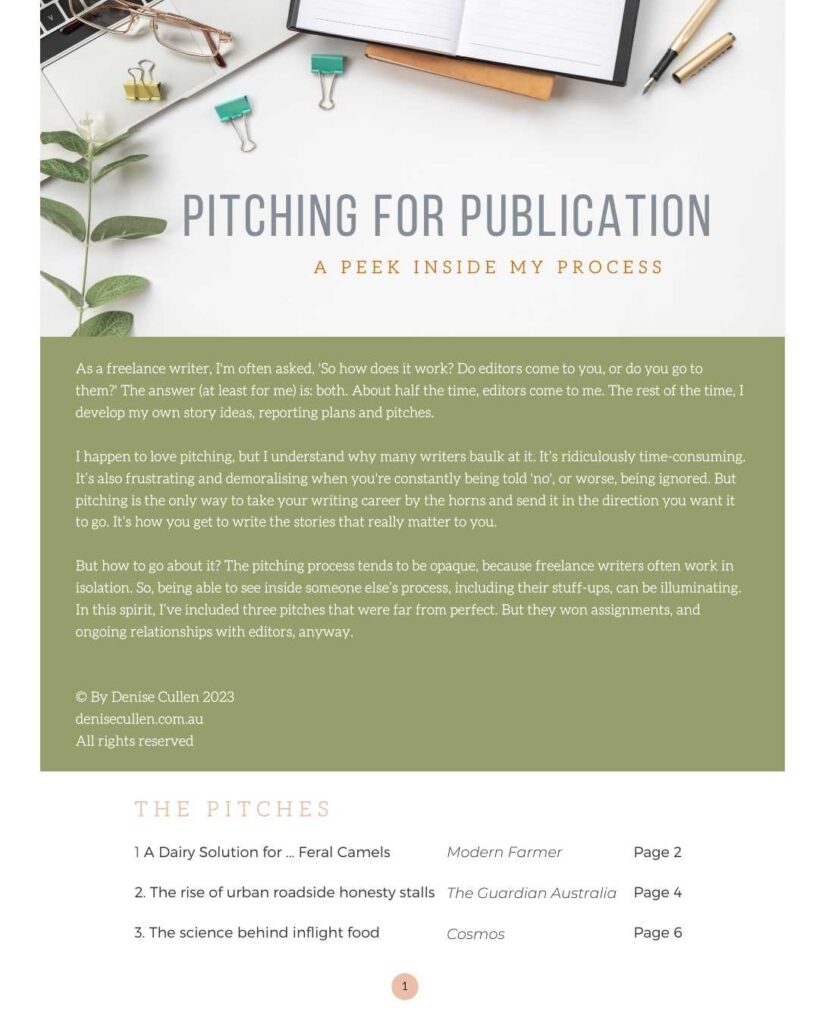Are you making this #1 pitching mistake? Here’s what editors really want – and how to give it to them.
There are many reasons why editors will reject a freelance pitch and not all of them are within your control.
But the biggest balls-up, according to editors, is failing to fully understand a publication before pitching.
Last week, I attended TravMedia’s Summit where, during the annual ‘Slam with Travel Editors’, four editors from print and digital publications took to the stage to outline their passions, pet peeves, and pitching preferences.
During this session, I always learn something new – or at least I’m reminded of something I did know, but have forgotten about, or gotten sloppy about, or didn’t fully grasp the first time around.
(After last year’s Summit, I wrote this story about the promises and perils of AI for the profession).
Are you making this common pitching mistake?
Pitching is a time-consuming process that comes with no guaranteed reward.
So, it’s understandable that in your haste to get your story ideas out into the world, you can overlook something that’s critically important.
That is: Your pitch must be exactly what an editor needs, at that very moment.
Put yourself in the editor’s shoes.
It’s like ordering a new dress – or a suit – online.
It’s a gamble.
You’re looking at photos of a size 8 model and wondering if that same pantsuit will also work for you.
Will it look as appealing? Will it be comfortable, or will you get hives from a tight, scratchy collar? Is it made of viscose or linen? Will it work with everything else in your wardrobe?
Are there enough pockets? Is the zip going to fall apart at the first sign of friction? Will it fit in all the right places? Or will it require a bunch of alterations before you can even walk out the door?
In much the same way, editors need to feel comfortable that freelance writers’ work (the published story) will live up to the promise (the pitch).
One of the main ways you can do that is by carefully examining the different pages, sections and columns of a publication before you so much think about typing, “Dear (Editor’s Name)”.
Thoroughly interrogating a publication with this level of forensic detail allows you to create a pitch that’s tailormade.
It’s a vital step that many writers – including myself – can overlook when pitching.
(You can read the gory details in my Pitching for Publication resource linked below.)

Here are 8 compelling reasons why you need to read several issues of a prospective publication back to front before you put your itchy pitchy fingers to the keyboard:
It allows you to craft a tailormade pitch
Understanding a publication, including its myriad different sections, ensures your pitch becomes a perfect fit.
For example, online destination pieces for Traveller (published in The Sydney Morning Herald and The Age) need to have a unique angle and an element of intrigue, says content director Trudi Jenkins.
“A lot of people pitch to us (and) basically describe the trip they’re going to do, or the (familiarisation trip) they’ve been offered that they’d like to do, and there’s nothing in it for me to go, ‘Why do I care?’ … or ‘Why will our readers care?’” she says.
When it comes to shaping these pitches, Jenkins’ hot tip is to look at the 10 (or so) word headlines on every story on the Traveller website.
(Current examples include ‘How to visit top museums around the world for free’ and ‘Rescued from decay, motel is now a prime Melbourne beach escape’).
“I see a pitch the same as an online heading,” she adds. “It’s 10 words – it’s literally your elevator pitch.”
It shows you’ve done your homework
Editors appreciate writers who subtly demonstrate their knowledge of a publication’s “furniture columns”, says Kate Cox, head of content and travel at Australian Community Media (ACM), publisher of Explore.
“My favourite freelancers are those who know their section,” she says.
“I hate the blanket pitch. I hate the people that pitch their diary. I hate the people that say, ‘I’ve been offered this cruise to (destination). Do you want a story?’”
“I like it when someone says, ‘Oh, this would be perfect for your Hungry Traveller column’.”
The takeaway? Avoid writing generic pitches that go out to everyone but appeal to no-one.
(Read more about how to Use these psychological principles to make your pitches irresistible.)
It highlights recurring columns to target
Many publications have regular columns with specific formats, so if you can tweak your idea to fit an existing column, you increase the odds that you’ll receive a resounding “Yes!”.
Many travel writers love to immerse themselves in long, adventure-led, narrative stories, but shorter service pieces will never go out of style (even though they’re not as sexy).
Traveller, for instance, runs a host of regular columns, including ‘Airline reviews’, ‘Airport reviews’, ‘Ship reviews’, and so on.
Seeking out these recurring columns can highlight stories you might have otherwise overlooked.
ACM readers, for instance, are based in regional areas of Australia, so city-based stories are exotic and interesting for them, says Cox.
“I’m always surprised that people aren’t pitching us city stories,” she adds.

It helps you avoid pitching duplicate ideas
Reviewing stories that have been published in the past allows you to sidestep topics that have already been covered – or, at the very least, lets you tackle them using a fresh angle.
Once, in haste, I pitched a (non-travel) editor a story idea that I thought was a sure thing.
Foolish, foolish girl.
They’d run pieces on the same subject several times previously.
To my chagrin, the editor sent me links to every one of those previous stories – presumably to underscore her irritation at me making this rookie error.
(Don’t worry. It wasn’t a fatal error. I worked with her again, but from then on, I was much more careful.)
It builds your understanding of tone and style
Reviewing a publication in detail allows you to identify the preferred tone, voice, word count and format.
Matching the style of the section you’re pitching improves the odds that your pitch will be accepted.
Often, you’ll be able to glean these distinctions from pitching guidelines on publication websites.
Travel + Leisure magazine, for instance, draws a clear distinction between its Experiences and Intelligent Traveler sections.
Experiences involve first-person narratives with a literary flourish, while Intelligent Traveler focusses on travel hacks and insider information, so these shorter pieces are “generally not first-person or based deeply in a personal experience, but rather synthesize trends or give directions”.
It’s all about showing you can nail the tone, style, voice, word count, and topic, right from the get-go.
It facilitates you extracting multiple stories from a single press trip
Gaining a deeper understanding of the requirements and nuances of individual publications and their various sections allows you to extract multiple stories from a single press trip (without pissing anyone off).
For example, The Australian (Travel + Luxury) runs a couple of semi-regular listicle style stories, such as ‘Take 5’ and ‘Perfect 10’.
Recent examples include John Borthwick’s ‘Fall in Love with Lisbon’ (a round-up of five things to do in the Portuguese capital) and Susan Skelly’s Magic Faraway Trees (featuring 10 “wooded wonders” around the world).
So, you might set off on a trip to write a first-person destination feature – while also keeping your eyes peeled for a series of tours, hotels, attractions, or other ‘things’ that are linked by theme.
There are other ways to do this too.
Read more about How I turned 1 trip into 14 stories.

It supports you spotting opportunities for sidebars
If a publication regularly runs sidebars, lists, Q and As, or ‘expert tips’ sections, there’s an opportunity to offer additional content beyond the main story idea.
For example, while conducting post-trek interviews for my story in Australian Geographic on The Stinson Walk, I learned that the pandemic-related search for fresh air, open spaces and solace in nature had dramatically increased the demands placed on national parks.
It wasn’t a central part of the story, but I thought it was an interesting and relevant (to the readership) side note.
Fortunately, the editor agreed, extending my word count and increasing my income for this assignment with minimal additional effort on my part.
Other times, you’ll be asked to provide extra assets, such as photos, videos, and social media posts.
But whether you’ll get paid for this additional content is a whole other question.
(The answer is almost always, ‘No.’)
Christian Barker, editorial director of Signature Luxury Travel, entered his new role after several years spent working as a freelance writer.
“(Freelancers) are now being asked by every editor … to not just go and do this travel experience and come back and write a story, but to also generate photography, video (and more), often for zero extra revenue, and it’s a big pressure,” he says.
My take? Try really, really hard not to resent all this “extra stuff” too much.
See if you can use it as a springboard to selling additional stories, words, or photographs, or to securing other publication opportunities.
It helps you uncover seasonal or thematic trends
Many publications follow editorial calendars or recurring themes – for instance, by running special editions (e.g., cruises, Japan, road trips) and columns centred on recurring themes.
Studying previous stories thus helps you time your pitch strategically – but bear in mind that long lead times usually apply.
December, for instance, is far too late to be pitching gift guide story ideas.
Traveller’s Jenkins says the editorial team is very aware of the perils of overtourism – so they’ve done a series of stories about “coolcations”, travel in the shoulder season, and “underrated and “overrated” destinations.
“People absolutely want to know, ‘Where’s next?’” she says.
“None of us want to go and have to get a ticket to see the Trevi fountain.”
Want more like this?
I’ll be looking at other pitching tips in my upcoming course.
In the meantime, I invite you to sign up for my fortnightly newsletter.
You’ll also receive a FREE copy of Pitching for Publication, which breaks down three successful pitches to Australian and international publications.

